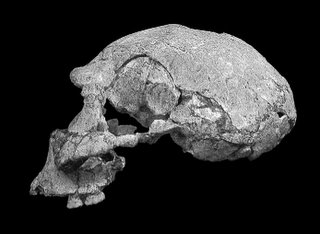 Dmanisi Skull D2282
Dmanisi Skull D2282 in
Georgia is a very important site in the understanding of human evolution so it is nice to see that a new paper on these finds is soon to be published in the journal of human evolution. The bones in this site are very well preserved so reveal alot of information about our ancestors. Dmanisi hominins are probably some of the earliest human ancestors to venture out of Africa - possibly due to greater intelligence enabling exploitation of new environments.
To get to Georgia the Dmanisi hominins must have travelled through Turkey - i wonder if there are more fossils of this age still to be found in this part of the world?
Anatomical descriptions, comparative studies and evolutionarysignificance of the hominin skulls from Dmanisi, Republic of Georgia
Philip Rightmire, David Lordkipanidze, Abesalom Vekua
Journal of human evolution - in press
Abstract: Evidence for ancient hominin occupation in Eurasia comes from Dmanisi in the Georgian Caucasus. Stratigraphic and sedimentological arguments,geochemical observations, paleomagnetic sampling and radiometric dates all point to the conclusion that bones and artifacts were depositedat this site during a brief interval following the close of the Olduvai Subchron (1.77 million years ago). In this report we presentfurther descriptive and comparative studies of the D2280 braincase, the D2282 partial cranium, now linked with the D211 mandible, and theskull D2700/D2735. The crania have capacities ranging from 600 cm3 to 775 cm3. Supraorbital tori and other vault superstructures are onlymoderately developed. The braincase is expanded laterally in the mastoid region, but the occiput is rounded. The pattern of sagittal keelingis distinctive. D2700 displays a prominent midfacial profile and has a very short nasoalveolar clivus. Also, the M3 crowns are reduced insize. Although there is variation probably related to growth status and sex dimorphism, it is appropriate to group the Dmanisi hominins together.With the possible exception of the large D2600 mandible, the individuals are sampled from one paleodeme. This population resembles Homohabilis in brain volume and some aspects of craniofacial morphology, but many of these features can be interpreted as symplesiomorphies. Otherdiscrete characters and measurements suggest that the Dmanisi skulls are best placed with H. erectus. There are numerous similarities to individualsfrom the Turkana Basin in Kenya, but a few features link Dmanisi to Sangiran in Java. Some traits expressed in the Dmanisi assemblageappear to be unique. Reconstructing the evolutionary relationships of these ancient populations of Africa and Eurasia is difficult, as the record isquite patchy, and determination of character polarities is not straightforward. Nevertheless, the evidence from anatomical analysis and measurementssupports the hypothesis that Dmanisi is close to the stem from which H. erectus evolved.
Some nice pictures of the excavation in progress and people involved:
http://www.fas.harvard.edu/~skeleton/pontzerDmanisi.htm

